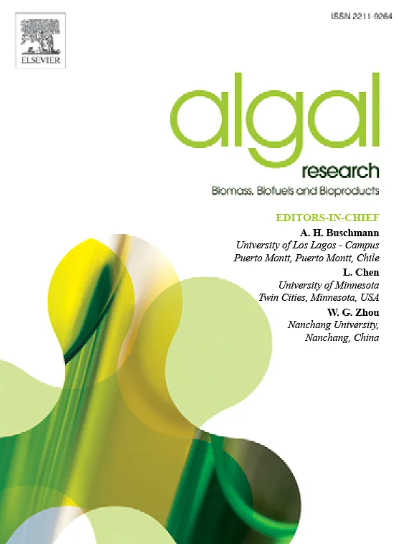Critical assessment of several filamentous algae as bioeconomic energy under different culture conditions
IF 4.6
2区 生物学
Q1 BIOTECHNOLOGY & APPLIED MICROBIOLOGY
Algal Research-Biomass Biofuels and Bioproducts
Pub Date : 2025-03-09
DOI:10.1016/j.algal.2025.103992
引用次数: 0
Abstract
This study systematically investigated the growth characteristics, cellular morphology, and intracellular biochemical profiles of four Trentepohliaceae strains, while concurrently examining the physiological responses of Tribonema sp. FACHB-1786 to varying light intensities, nitrogen sources and concentrations. Comprehensive compositional analysis through GC–MS and HPLC revealed that oleic acid (C18:1) predominated the fatty acid profile, accounting for approximately 50 % of total fatty acids, with β-carotene representing 50 %–60 % of the total pigment content in Trentepohliaceae strains. The biodiesel production potential of Tribonema sp. FACHB-1786 was rigorously evaluated using established fuel quality parameters, demonstrating favorable lipid characteristics for renewable energy applications. Notably, the strain exhibited significant eicosapentaenoic acid (EPA) accumulation, reaching 15.6 % of total fatty acids during peak lipid production. As a clinically validated omega-3 polyunsaturated fatty acid, EPA demonstrates dual functionality in therapeutic applications through its hypolipidemic effects and immunomodulatory properties. This substantial EPA content positions Tribonema sp. as a promising candidate for nutraceutical development and functional food formulations. The experimental data suggest optimized cultivation strategies for enhancing both biodiesel precursors and high-value metabolites in algal biotechnology applications. The dual-output potential (bioenergy and nutraceuticals) demonstrated in this study presents a compelling case for integrated biorefinery approaches in microalgal biomass utilization.

求助全文
约1分钟内获得全文
求助全文
来源期刊

Algal Research-Biomass Biofuels and Bioproducts
BIOTECHNOLOGY & APPLIED MICROBIOLOGY-
CiteScore
9.40
自引率
7.80%
发文量
332
期刊介绍:
Algal Research is an international phycology journal covering all areas of emerging technologies in algae biology, biomass production, cultivation, harvesting, extraction, bioproducts, biorefinery, engineering, and econometrics. Algae is defined to include cyanobacteria, microalgae, and protists and symbionts of interest in biotechnology. The journal publishes original research and reviews for the following scope: algal biology, including but not exclusive to: phylogeny, biodiversity, molecular traits, metabolic regulation, and genetic engineering, algal cultivation, e.g. phototrophic systems, heterotrophic systems, and mixotrophic systems, algal harvesting and extraction systems, biotechnology to convert algal biomass and components into biofuels and bioproducts, e.g., nutraceuticals, pharmaceuticals, animal feed, plastics, etc. algal products and their economic assessment
 求助内容:
求助内容: 应助结果提醒方式:
应助结果提醒方式:


